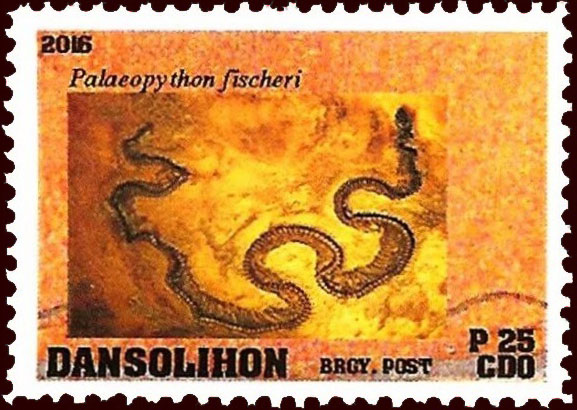Paleopython fischeri Schaal, 2004

(Da: en.wikipedia.org)
Phylum: Chordata Haeckel, 1874
Subphylum: Vertebrata Cuvier, 1812
Classe: Reptilia Laurenti, 1768
Ordine: Squamata Oppel, 1811
Famiglia: Boidae Gray, 1825
Genere: Palaeopython Rochebrune, 1880
Specie e sottospecie
Il genere annovera attualmente le seguenti specie: Palaeopython cadurcensis Filhol, 1877 - Palaeopython ceciliensis Barnes, 1927 - Palaeopython helveticus Georgalis & Scheyer, 2019- Palaeopython neglectus Rochebrune, 1884.
Descrizione
Raggiungeva circa i due metri e sembra fosse arboricolo; come i suoi parenti contemporanei, i boa, probabilmente scendeva a terra e raggiungeva le acque dei fiumi o dei laghi.
Diffusione
Genere di serpente estinto vissuto nell'Eocene, i suoi resti sono stati trovati nella formazione Messel in Germania.
Bibliografia
–Georgalis, G.L.; Scheyer, T.M. (2019). "A new species of Palaeopython (Serpentes) and other extinct squamates from the Eocene of Dielsdorf (Zurich, Switzerland)" (PDF). Swiss Journal of Geosciences. 112 (2–3): 383-417.
–Scanferla, A.; Smith, K.T. (2020). "Exquisitely Preserved Fossil Snakes of Messel: Insight into the Evolution, Biogeography, Habitat Preferences and Sensory Ecology of Early Boas". Diversity. 12 (3): 100.
–Georgalis, G.L.; Rabi, M.; Smith, K.T. (2021). "Taxonomic revision of the snakes of the genera Palaeopython and Paleryx (Serpentes, Constrictores) from the Paleogene of Europe". Swiss Journal of Palaeontology. 140 (1): 18.
–Delfino, M.; Zoboli, D.; Carnevale, G.; Pillola, G.L. (2014). "The rediscovered holotype of Palaeopython sardus Portis, 1901 from the Miocene of Sardinia belongs to a fish, not to a snake" (PDF). Bollettino della Società Paleontologica Italiana. 53 (2): 89-92.

|
Data: 01/01/2016
Emissione: Animali preistorici (Francobolli privati) Stato: Philippines |
|---|